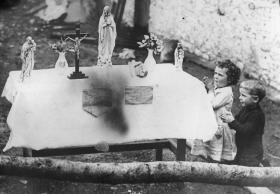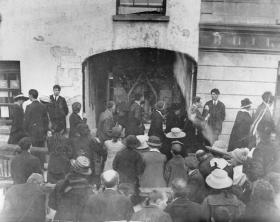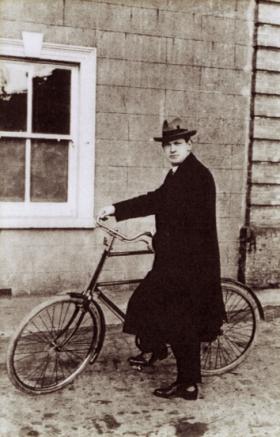The Templemore miracles
Published in 20th-century / Contemporary History, Features, Issue 1 (Jan/Feb 2009), Revolutionary Period 1912-23, Volume 17
Above: The improvised altar that had been erected in a yard beside Dwan’s shop, Templemore, 22 August 1920. (National Photographic Archive)
On the night of 16 August 1920 ‘wild scenes were witnessed’ in Temple-more as the North-amptonshire Regiment carried out reprisals following the killing of RIC District Inspector Wilson by the IRA. According to a local press report, ‘soldiers joined in the outbreak . . . volleys were fired, houses attacked, shops looted, the town hall was burned down, and three creameries destroyed’. (Ironically, two members of the regiment, Captain S. H. Beattie MC and Lance Corporal H. J. Fuggle, were to lose their lives in the fire.)
‘Our Lady had saved Templemore’
Immediately after these deaths, reports of ‘supernatural manifestations, accompanied by cures’, in Templemore and also in the townland of Curraheen, near the village of Gortagarry, appeared in local and national newspapers. It was alleged that religious statues at several premises, including the RIC barracks in Templemore, were shedding tears of blood. It was reported that local farm labourer James Walsh was experiencing Marian apparitions, and that a ‘holy well’ had appeared in his bedroom floor. The Tipperary Star reported that ‘after the outburst on Monday night some of the statues from which blood had been oozing were taken by Walsh to Templemore, and it is believed that it was this that saved the town from destruction’. The Limerick Leader reported that ‘prominent townsmen assembled around the bleeding statues and offered prayers aloud, thanking God that the town was saved on Monday night, and that none of the inoffensive people of Templemore suffered any casualties’. Some believed that divine intervention had prevented the town from being completely destroyed in revenge for the death of DI Wilson, and that ‘Our Lady had saved Templemore’.
On 31 August 1920, RIC County Inspector Dunlop reported to Dublin Castle:
‘On 20th inst. miraculous apparitions are alleged to have appeared in Templemore and Curraheen. Sacred statues belonging to a man named Walsh and a constable Wimsey stationed at Templemore are alleged to have begun to bleed, and several miraculous cures are said to have taken place.’
By 4 September Dunlop estimated that more than 15,000 persons per day were making the pilgrimage to Templemore and onwards to Curraheen. Dunlop removed the statue from the barracks and placed it with other statues on an improvised altar that had been erected in a yard beside Dwan’s shop. This followed an incident during which the barracks was besieged by a large crowd of pilgrims anxious to see the bleeding statue. People entered the barracks and had to be forcibly removed by the RIC. Wimsey left the police shortly afterwards, reportedly to ‘join a religious order’. Dunlop told Dublin Castle that the alleged miracles were having a positive effect on the locality, describing the conduct of the large crowds as ‘exemplary’. Templemore was referred to as ‘Pilgrimville’ or ‘Pilgrimstown’ by newspapers, and to cater for the thousands of pilgrims categorised by newspapers as ‘the halt, the maim and the blind’, additional trains originating from Kingsbridge station in Dublin were added to the normal schedule. Revd Collier, a correspondent for the Catholic Times, visited Templemore and estimated that 6,000 to 8,000 people were at Dwan’s, many of them having been there overnight. He saw four statues, each with blood trickling down the face, neck, breasts and body.
Miraculous cures claimed
As reports of the apparitions and miracles spread, the number of pilgrims increased. Many people claimed to have been healed either by direct contact with Walsh or by exposure to the bleeding statues or crucifix. Some visitors were not convinced, however, and one journalist wrote that he came ‘to see a miracle and saw one. It was not a miracle of bleeding statues but of pathetic belief.’ The Limerick Leader reported the case of former soldier Martin Monahan, the first person claiming to have been cured by Walsh. Monahan had spent three years in the military hospital at Richmond Barracks with shrapnel injuries. He claimed to have entered Dwan’s yard on crutches but left ‘with full use of his limbs’ after Walsh had touched his legs with one of the statues. Other well-publicised cases included those of a Miss Guerin and a Mr Gavin of Limerick, who were reportedly cured of ‘paralysis’ and ‘acute hip disease’ respectively.
The official position of the Catholic Church was one of ‘extreme reserve’, and at the height of the religious fervour that surrounded the miracles Bishop Fogarty of Limerick warned Mass-goers that ‘they should restrain their judgement and not allow themselves to be carried away by excitement or popular rumour’. The parish priest of Templemore, Revd Kiely, refused to visit the statues, expressing the opinion that great caution needed to be exercised. Walsh travelled to other towns in the company of clergy, visiting Mount Mellary and Cashel, where he stayed as the guest of Monsignor Innocent Ryan. The Irish Times reported that statues and a crucifix in the presbytery in Cashel had begun to bleed when touched by Walsh, and as the news spread ‘a piteous and clamorous crowd of invalids’ arrived at the presbytery and requested that they be allowed to see and touch the statues that were on display outside the building. Monsignor Ryan wrote to the Irish Times in an attempt to stem the flow of pilgrims and to prevent events similar to those occurring at Templemore and Curraheen also taking place in Cashel.
IRA gets involved
Reporting the miracles to IRA GHQ, Vice-Commandant Edward McGrath stated that the town was packed with ‘pilgrims, beggars, stall-holders and undesirables. The police and military had disappeared off the streets and the IRA had taken over. They controlled traffic, introduced parking and restored order.’ The IRA acted as stewards and marshals but did not appear on the streets in uniform. They took advantage of the absence of the military and police from the streets to reconnoitre suitable locations for ambushes, and local IRA commander Jimmy Leahy imposed a levy of 2/6d per day on all cars bringing pilgrims from Templemore to Curraheen. Ostensibly the levy was imposed to pay for repairs to local roads that had been damaged by the throngs of pilgrims, and to pay the expenses of IRA men involved in traffic and crowd control duty. The imposition of the levy caused an outcry, and Count O’Byrne, Sinn Féin TD and chairman of North Tipperary County Council, met Leahy and pointed out that the levy was highly irregular. Leahy replied that ‘everything had to be irregular to deal with the situation that had arisen’. The count suggested that the council should take over the collection of the levy but Leahy refused, saying that he intended to buy arms and ammunition with any balance left over after deducting the Volunteers’ expenses. Pilgrims were reported to be loud in their praise of the ‘splendid men of Óglaigh na hÉireann’ who maintained order and prevented excessive profiteering by shopkeepers, caterers and hoteliers. Such activities were severely dealt with by the IRA, who imposed a scale of charges after ‘due enquiry, deliberation and consideration of the abnormal conditions prevailing’. Collection boxes for the IRA and Cumann na mBán were placed along the pilgrimage route and this provided a substantial windfall for the IRA, with a total of £1,500 contributed, which was subsequently delivered to the brigade quartermaster.
Several days after the miracles began, Leahy and other IRA officers interrogated Walsh. They had started to view the ‘whole business with incredulity’, and were also seriously concerned that Volunteer discipline was being compromised. Pilgrims had begun to lavishly tip the IRA men, with the result that some Volunteers, who had previously been abstemious and enthusiastic, ‘took to drink and began to forget that they were engaged in a life and death struggle for the country’s freedom’. Walsh told Leahy that when he had conversed with the Virgin Mary she had indicated her approval of guerrilla tactics, including the shooting of Black and Tans, and wished to see the campaign intensified. Leahy and the others found it difficult ‘to keep a straight face’ and concluded that Walsh was either ‘mentally abnormal or a hypocrite’. Leahy felt that the bizarre situation could not be allowed to continue, and also demanded that Walsh hand over some of the money that had been given to him by pilgrims. Walsh gave £75 to Leahy and this money was also passed to the quartermaster.

Crowds milling about the entrance to Dwan’s yard, 22 August 1920. (National Photographic Archive)
Following this meeting, Leahy visited Canon Ryan in Thurles and requested that the apparitions be denounced from the pulpit, thereby deterring pilgrims from travelling to Templemore. Canon Ryan did not comply. Leahy also contacted Michael Collins to express his concern about the detrimental effect the situation was having on IRA operations. Collins ordered Dan Breen to contact ‘the fellow who operates the bleeding statue’ and interview him, to which Breen reluctantly agreed. Walsh was taken to Dublin and interrogated by Breen, while Collins waited in the next room. Breen reported back to Collins that Walsh ‘was a fake’, or possibly even a spy, and his opinion that the apparitions and miracles were not genuine. Collins sarcastically replied, ‘One can’t take any notice of what you say, Breen, because you have no religion’. Phil Shanahan, who owned a pub in Dublin frequented by IRA members, was asked by Breen to drive the visionary to Templemore, and that was the last Breen saw of the ‘failure Walsh’. On his return, Shanahan offered Breen water from the holy well at Curraheen to drink, but Breen declined the offer. Having been rebuffed by Canon Ryan and the Catholic Church, the IRA decided to resume the war in any case. On 29 September 1920 the IRA attacked a group of RIC men near Goldings Cross RIC barracks, which was on the pilgrimage route between Templemore and Curraheen. Constables Noonan and Flood were killed and two others wounded. After the ambush, a group of pilgrims were stopped by the IRA and forced to complete their journey with the ‘dead bodies of the two policemen thrown across their knees in the car’.
As the IRA had intended, the ambush brought a substantial number of military and police reinforcements to the area, who engaged in a ‘reign of terror by indulging in indiscriminate firing into houses and across fields’. The Northamptonshire Regiment went to the holy well at Curraheen and Dwan’s yard in Templemore, where they removed crutches and other items left behind by pilgrims. Some soldiers decorated themselves with religious artefacts, while others feigned lameness and began using the crutches, parading the streets in mockery of the miracles. Rumours spread like wildfire that Templemore would be burned to the ground as a reprisal for the ambush, and pilgrims, stall-holders and tramps all made a hasty exit. Within 24 hours the town had returned to normality.
Michael Collins sent a courier to Tipperary to acquire one of the bleeding statues. Collins had received information from the local Catholic clergy that IRA Volunteers had engineered statues that would bleed at specific times. The internal mechanism of an alarm clock had been concealed inside the statue, connected to fountain pen inserts containing a mixture of sheep’s blood and water. When the clock mechanism struck at certain times it would send a spurt of blood through the statue, giving the impression that it was bleeding. According to an eye-witness, Collins
‘. . . took hold of the statue and banged it off the side of the desk, and of course out fell the works of the alarm clock. “I knew it”, he says. So that was the end of the bleeding statue.’
Shortly afterwards, local people heard that James Walsh had left for Australia. In 1947 he was granted Australian citizenship while living in Stawell, Victoria. HI

Michael Collins—ordered Dan Breen to contact ‘the fellow who operates the bleeding statue’ and interview him. (Chrissy Osborne, Michael Collins: a life in pictures (Mercier Press). See ‘Bookworm’, p. 54.)
Sergeant John Reynolds is attached to the Garda Síochána College, Templemore, and established its museum in 2002.
Further reading:
R. Abbott, Police casualties in Ireland 1919–1922 (Dublin, 2000).
K. Griffith and T. O’Grady, Curious journey: an oral history of Ireland’s unfinished revolution (Dublin, 1998).
J. Nickel, Looking for a miracle: weeping icons, relics, stigmata, visions and healing cures (New York, 1993).
















